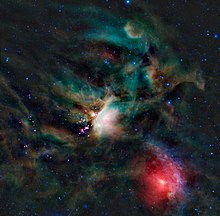Sigma Scorpii
| Observation data J2000.0
| ||
|---|---|---|
| Constellation | Scorpius | |
| Right ascension | 16h 21m 11.31571s[1] | |
| Declination | −25° 35′ 34.0515″[1] | |
| Apparent magnitude (V) | +2.88[2] | |
| Characteristics | ||
| Spectral type | B1 III[3] + B1 V[4] | |
| U−B color index | −0.70[2] | |
| B−V color index | +0.13[2] | |
| Absolute magnitude (MV) | −4.12±0.34 / −3.32±0.34[4] | |
Argument of periastron (ω)(secondary) | 283±5° | |
| Details | ||
| σ Sco Aa1 | ||
Myr | ||
| σ Sco Aa2 | ||
| Mass | 11.9±3.1[4] M☉ | |
| Radius | 11[4] R☉ | |
| Luminosity | 16000±4000[4] L☉ | |
| Database references | ||
| SIMBAD | data | |
Sigma Scorpii (or σ Scorpii, abbreviated Sigma Sco or σ Sco), is a
−59 light years (174+23
−18 parsecs).[4]
The system consists of a
Nomenclature

σ Scorpii (Latinised to Sigma Scorpii) is the star system's Bayer designation. The designations of the four components as Sigma Scorpii Aa1, Aa2, Ab and B derive from the convention used by the Washington Multiplicity Catalog (WMC) for multiple star systems, and adopted by the International Astronomical Union (IAU).[14]
Sigma Scorpii and Tau Scorpii together bore the traditional name Al Niyat (or Alniyat) derived from the Arabic النياط al-niyāţ "the arteries" and referring to their position flanking the star Antares, the scorpion's heart, with Sigma Scorpii just to the north.[15]
In 2016, the
In
The indigenous
Properties

The brightest component of the system, Sigma Scorpii Aa, is a double-lined
The primary component of the spectroscopic binary, Sigma Scorpii Aa1, is an evolved giant star with a stellar classification of B1 III.[3] It has around 18 times the mass of the Sun and 12 times the Sun's radius.[4] This star is radiating about 29000 times the luminosity of the Sun from its outer envelope at an effective temperature of 26150 K.[4] This is a variable star of the Beta Cephei type, causing the apparent magnitude to vary between +2.86 and +2.94 with multiple periods of 0.2468429, 0.239671, and 8.2 days. During each pulsation cycle, the temperature of the star varies by 4000±2000 K.[4] The other member of the core pair, Sigma Scorpii Aa2, is a main sequence star with a classification of B1 V.[4]
Orbiting this binary at a separation of half an
Given its position, youth, and space velocity, the Sigma Scorpii system is a likely member of the
References
- ^ S2CID 18759600.
- ^ Bibcode:1966CoLPL...4...99J.
- ^ Bibcode:1988mcts.book.....H
- ^ S2CID 14636283
- Bibcode:1953GCRV..C......0W.
- ^ S2CID 118461108.
- S2CID 14295631. Note: value taken from [m/H].
- doi:10.1086/340590
- S2CID 118629873
- ^ "sig Sco". SIMBAD. Centre de données astronomiques de Strasbourg.
- ISBN 978-1-931559-44-7.
- ^ a b "Naming Stars". IAU.org. Retrieved 16 December 2017.
- ^ "Washington Double Star Catalog". United States Naval Observatory. Archived from the original on 14 February 2011. Retrieved 2 January 2018.
- arXiv:1012.0707 [astro-ph.SR].
- ISBN 0-486-21079-0.
- ^ "International Astronomical Union | IAU". www.iau.org. Retrieved 2017-03-31.
- ^ "WG Triennial Report (2015-2018) - Star Names" (PDF). p. 5. Retrieved 2018-07-14.
- ISBN 978-986-7332-25-7.
- ^ (in Chinese) 香港太空館 - 研究資源 - 亮星中英對照表 Archived 2008-10-25 at the Wayback Machine, Hong Kong Space Museum. Accessed on line November 23, 2010.
- S2CID 118454721.
- ^ "Light Curve". Hipparcos ESA. ESA. Retrieved 17 February 2022.
- S2CID 15785349

